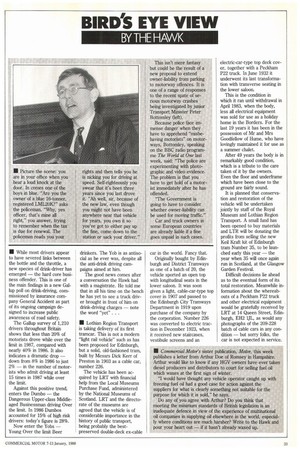• While most drivers appear to have severed links between
Page 35

If you've noticed an error in this article please click here to report it so we can fix it.
the bottle and the throttle, a new species of drink-driver has emerged — the hard core business offender. This is one of the main findings in a new Gallup poll on drink-driving, commissioned by insurance company General Accident as part of its ongoing campaign designed to increase public awareness of road safety.
The Gallup survey of 1,210 drivers throughout Britain shows that less than 20% of motorists drove while over the limit in 1987, compared with nearly 40% in 1986. It also indicates a dramatic drop — down from 8% in 1986 to just 2% — in the number of motorists who admit driving at least 15 times in 1987 while over the limit.
Against this positive trend, enters the Dumbo — the Dangerous Upper-class Middleaged Businessman driving Over the limit. In 1986 Dumbos accounted for 15% of high risk drivers: today's figure is 28%.
Now enter the Yobs — Young Over the limit Beer drinkers. The Yob is as antisocial as he ever was, despite all the anti-drink driving campaigns aimed at him.
The good news comes after a conversation the Hawk had with a magistrate. He told me that in all his time on the bench he has yet to see a truck driver brought in front of him on drink-driving charges — note the word "yet" . . .
Lothian Region Transport is taking delivery of its first tramcar. This is not a modern "light rail vehicle" such as has been proposed for Edinburgh, but a solid, old-fashioned tram, built by Messrs Dick Kerr of Preston in 1903 as a cable car, number 226.
The vehide has been acquired by LRT with financial help from the Local Museums Purchase Fund, administered by the National Museums of Scotland. LRT and the directorate of the museums are agreed that the vehicle is of considerable importance in the history of public transport, being probably the bestpreserved double-deck ex-cable car in the world. Fancy that.
Originally bought by Edinburgh and District Tramways as one of a batch of 20, the vehicle sported an open top with longitudinal seats in the lower saloon. It was soon given a light, cable-car-type top cover in 1907 and passed to the Edinburgh City Tramways Department in 1919 upon purchase of the company by the corporation. Number 226 was converted to electric traction in December 1923, when it received new staircases, vestibule screens and an electric-car-type top deck cover, together with a Peckham P22 truck. In June 1932 it underwent its last transformation with transverse seating in the lower saloon.
This is the condition in which it ran until withdrawal in April 1983, when the body, less all electrical equipment was sold for use as a holiday home in the Borders. For the last 19 years it has been in the possession of Mr and Mrs Goodfellow of Hume, who have lovingly maintained it for use as a summer chalet.
After 49 years the body is in remarkably good condition, which is a tribute to the care taken of it by the owners. Even the floor and underframe which have been close to the ground are fairly sound.
It is planned that conservation and restoration of the vehicle will be undertaken jointly by staff of the Royal Museum and Lothian Region Transport. A small fund has been opened to buy materials and LTR will be donating the profits from selling the new Keil Kraft kit of Edinburgh tram Number 35, to be launched early this year — the year when 35 will once again run in Scotland, at the Glasgow Garden Festival.
Difficult decisions lie ahead as to the eventual form of its total restoration. Meanwhile information about the whereabouts of a Peckham P22 truck and other electrical equipment would be gratefully received by LRT at 14 Queen Street, Edinburgh, EH2 1JL, as would any photographs of the 209-228 batch of cable cars in any condition — but sorry folks, the car is not expected in service.
































































